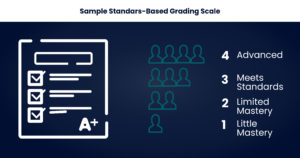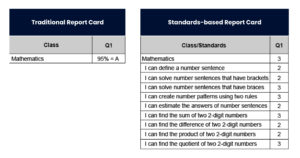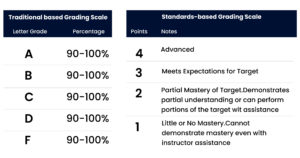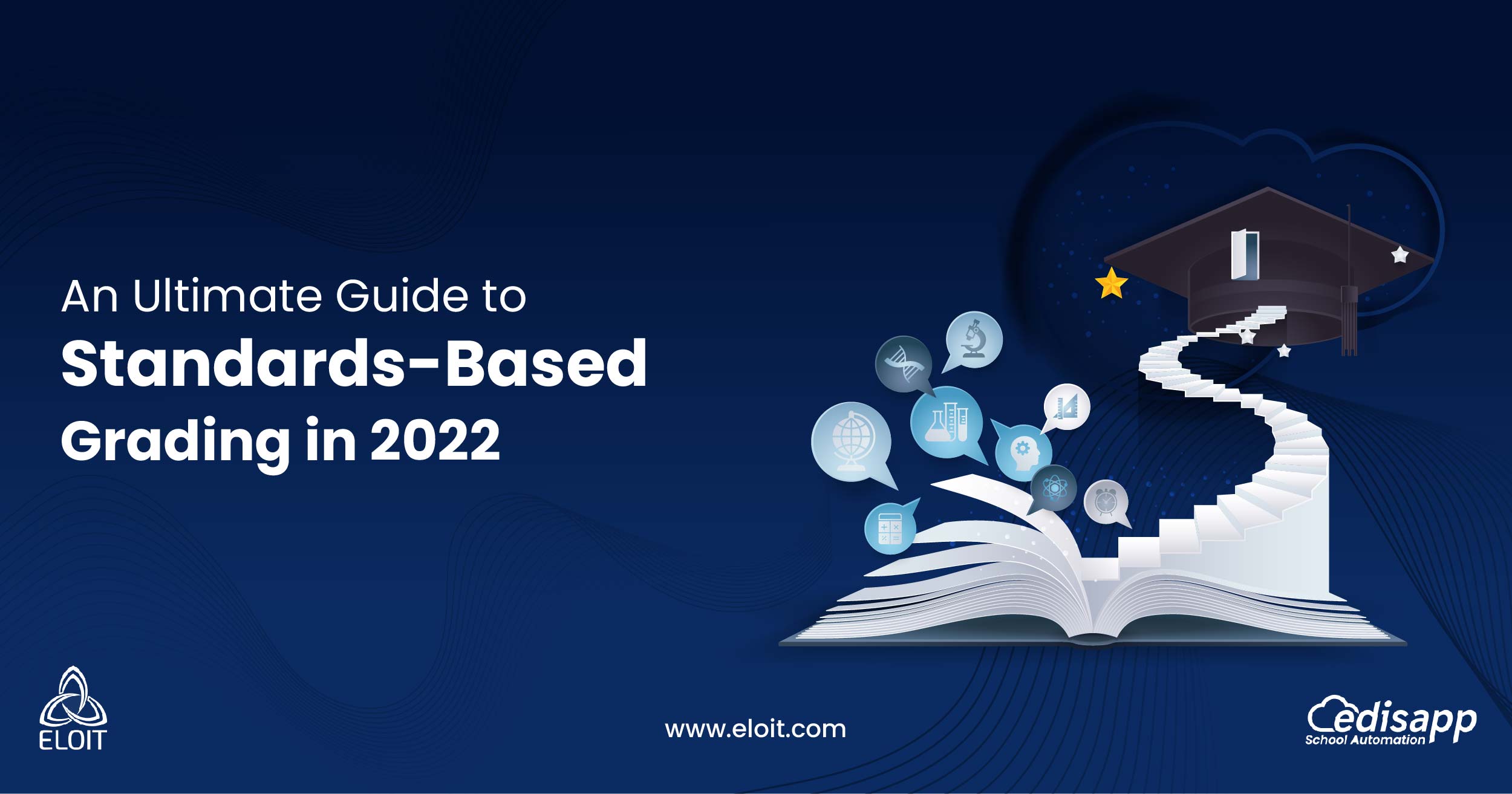Free Demo
Standards-based Grading!
We expect schools to introduce innovative ideas and changes to teaching methods. Among the innovations we look forward to, standards-based grading or SBG is the most important one. It gauges student proficiency on well-defined course objectives. Even though some schools have already employed this technique along with traditional grading methods, SBG deserves more popularity and recognition.
Poor grades negatively impact the mental health of students. It will be difficult for students to find out what they did wrong and how or where to improve. When we compare standards-based grading vs. traditional grading, the latter one is vague and provides no creative opportunities for students to improve. It is the main reason why schools should switch to standards-based grading.
Now let us explore standards-based grading and how it benefits teachers and students in detail.
What is Standards-based Grading?
Standards-based grading is a technique in education that evaluates a student's performance towards mastering specific learning targets called standards. These standards can be set on different levels like school, state, or national. This grading system mainly focuses on the effectiveness of lectures and mastery of skills for a specific subject.
In this innovative grading technique, teachers can easily track student progress and improve their learning potential. This method allows students to determine which learning standards they have mastered and which of them needs improvements. Students will be provided with a unique grade for learning standards that should be mastered at the end of the course.
SBG ensures that students can demonstrate mastery skills at the end of the year. Because, educators align projects, assignments, and homework with learning standards that students are expected to master.
There’s an SBG scale that ranges from number 1 to 4 that defines a student’s mastery of a specific standard. For example, a score of 1 defines that a student has less understanding of the concept. A score of 3 indicates that a student has good understanding while a score of 4 shows that the student has mastered the learning standards beyond expectation.

How Does SBG (Standards-based grading) Improve Education?
Since you have understood what SBG is, let’s learn how this innovative grading system improves education.
-
Better Feedback
Instead of providing scores like letters or numbers, this method allows teachers to give more meaningful feedback that powers student growth. It helps students to identify the areas that need improvement and grow quickly. It also speeds up the learning process and helps students to achieve greater heights quickly.
-
Student Ownership of Education
Unlike the traditional grading system where students find it difficult to understand complex grading methods, SBG uses a student-friendly grading method. It allows students to easily identify their mistakes and correct them in time. It gives them complete ownership of their learning process to better understand the path to success.
-
Meaningful Instruction
As you know, each student learns at different paces. SBG allows teachers to know exactly where the students are in the learning process. Each stage like introductory learning, intermediate learning, etc., is numbered as 1, 2, 3, and so on. This method makes students stress-free and also helps teachers to teach according to the level of students.
-
Improved Motivation
In the traditional grading system, students are encouraged to get more marks and grades. It makes them less motivated and more stressed. All they do is memorize what's given in the textbooks to get high marks. It doesn't allow them to learn or understand a topic rather than memorize them. But Standards-based grading focuses more on learning and mastery. It keeps students highly motivated to master the learning standards without forcing them.
-
Emotional Safety
The grades of students in the traditional grading system highly rely on the mistakes they make. More mistakes a student makes, the fewer grades he gets. It induces a fear of tests and anxiety in students that affect their learning process. In standards-based grading, the final grades are based on the mastery of students in the learning standards. This makes them emotionally safe and allows them to make mistakes, learn from them and grow.
-
More Accurate Measurement
The traditional grading system mainly tests the memory power of students rather than challenging their skills, interests, or learning abilities. On the other hand, a standard-based learning system offers a better method for measuring the student's mastery of the subject. It is more accurate since the grades obtained by students depend on the mastery level of learning standards.
How Does SBG Benefit Teachers and Students
Since SBG is a proven technique that allows teachers to measure student proficiency, it has many features that benefit teachers and students.
Let’s see how this method benefits teachers:
- Since SBG is more focused on learning and mastering, teachers and students can work more closely together.
- Teachers engage better with other teachers of the same level since their goals are identical.
- Collaboration and understanding between teachers are improved.
- Since the expectations of students are clear, the same reflects in teachers as well.
- As mentioned above, teachers know exactly where their students stand and who needs extra support and guidance.
- It also makes evaluation easier and teachers can easily identify the areas that need improvements.
The benefits that students get from SBG system are -
- Students can control their learning process.
- They can also monitor their progress and achieve their targets quickly.
- Students have a clear idea about all their learning objectives.
- All their assessments and projects are linked to their learning standards for easy understanding.
- It allows students to think practically and relate to real world problems.
- Students will get many chances to demonstrate their proficiency.
- Teaching methods meet all the requirements of students.
- All students are given opportunities to showcase their highest potential.
Advantages of SBG
Hope you have understood how SBG benefits students and teachers. Now let's jump into the overall advantages of this approach.
-
Improved Student Engagement
This method allows students to get clear about the objectives behind their assessments. The learning standards are written in student-friendly language that makes them more engaged in classroom activities. Students will understand that their main goal is to master the standards rather than get high grades.
-
Parents Involvement
Parents cannot identify the interests and talents of their children by merely looking at their grades. On the other hand, SBG clearly defines the strengths and weaknesses of students. It helps parents to help their kids from home and provide proper support.
-
Accurate and Consistent Measurement
The traditional grading system may not give you the exact measurements of a student's abilities. For example, even if a student understood a topic clearly, he will get low grades if he is not able to perform well in final exams. But in SBG, the performance of students doesn't depend only on final exams. The students are given assessments throughout their course based on their learning standards.
-
Growth Mindset
Students will only focus on getting good grades in the traditional grading system. The fear of getting low marks will put them in stress and anxiety. It will affect their learning process and mindset. SGB allows students to practice their mastery of standards without stressing them in the name of poor grades. It allows them to have a growth mindset and learn from their mistakes.
-
Quality Curriculum and Assessments
SBG mainly focuses on quality rather than quantity. It doesn't feature bulky textbooks like traditional learning systems. The instruction and assessments are in a student-friendly manner. It allows students to demonstrate their proficiency with ease. It uses a high-quality curriculum to improve learning standards and tackle real-world problems.
-
Reduce Paperworks
SBG allows you to reduce paperwork and utilize your time for other critical tasks. Teachers need to write feedback only for selected homework problems to save time. Also, here teachers don't have to conduct assessments until they ensure the majority of the students follow the lecture. Thus, this innovative technology reduces the number of meaningless paperwork and improves the quality of assessments.
Standards-based grading Examples
When it comes to Standards-based grading vs. traditional grading, the former simplifies subject matter into smaller "learning targets." A teacher observes the student's understanding of each learning target. To better know about standards-based grading examples, consider a mathematics report card. The simplified learning targets of this report card will be;

- I can define a number sentence
- Able to find the sum of two 2-digit numbers
- Easily identify the difference between two 2-digit numbers
- I can find the product of two 2-digit numbers
In science and social studies, the learning standards will look like,
- Able to understand the concepts
- I can demonstrate knowledge activities
Likewise, standards-based grading examples will differ from subject to subject. In SBG, the grading depends on the demonstration of mastery. It aligns assessments, projects, and assignments with the learning standards of each student. Teachers analyze the results of these assessments and select the appropriate mastery level for students.
As we already discussed, SBG uses a typical 1-4 scale for evaluation. Each number reflects the understanding level of students on different topics. Teachers use this grading scale to evaluate students and determine the level of mastery.

Conclusion
SBG is less popular and often contrasted with traditional approaches. But after knowing the importance and benefits of SBG, any school will try to incorporate it. It is an ideal measurement of students' performance efficiency. Its advantages completely outweigh the disadvantages and make it a practical method.
We recommend you use Edisapp., a school management software developed by Eloit Technologies.

